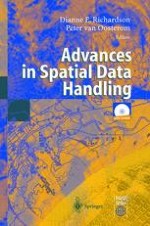2002 | OriginalPaper | Buchkapitel
Detecting Building Alignments for Generalisation Purposes
verfasst von : Sidonie Christophe, Anne Ruas
Erschienen in: Advances in Spatial Data Handling
Verlag: Springer Berlin Heidelberg
Enthalten in: Professional Book Archive
Aktivieren Sie unsere intelligente Suche, um passende Fachinhalte oder Patente zu finden.
Wählen Sie Textabschnitte aus um mit Künstlicher Intelligenz passenden Patente zu finden. powered by
Markieren Sie Textabschnitte, um KI-gestützt weitere passende Inhalte zu finden. powered by
Generalisation is well recognised as a complex process that should trigger specific algorithms, on different types of objects in some logical or appropriate order. To guide the process (where and how to generalise) one solution is to distinguish characterisation from the generalisation process. Characterisation aims at finding and describing relevant ‘working areas’ that can be a part of an object or a set of objects. As a result, the choice of an appropriate algorithm(s) becomes easier and can be constrained by the detected properties of this new entity. This paper presents a method to both detect and characterise building alignments in an effort to improve the use of generalisation algorithms namely typification and displacement. The first step consists of the identification of building alignments from straight-line templates. The second step characterises these alignments to retain only those that are perceptually regular. The characterisation is based on an analysis of the spatial location of buildings as well as on the properties of the buildings that belong to the alignment in question. To evaluate the regularity of the distribution, estimators are proposed for each property.. At the end a global quality estimator of the perceptual alignment- based on the aggregation of the estimators — is proposed. This global estimator is used to retain the best building alignments that will then be carefully generalised. The results presented have been implemented in the Lamps2 GIS software.
